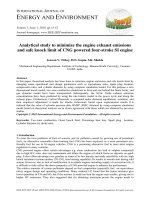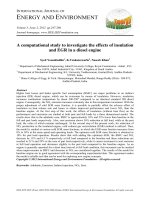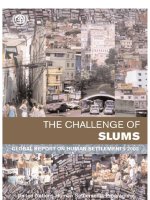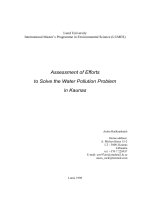- Trang chủ >>
- Khoa Học Tự Nhiên >>
- Vật lý
Theoretical physics to face the challenge of LHC lecture notes of the les houc
Bạn đang xem bản rút gọn của tài liệu. Xem và tải ngay bản đầy đủ của tài liệu tại đây (7.9 MB, 439 trang )
www.pdfgrip.com
Theoretical Physics to Face the Challenge of LHC
www.pdfgrip.com
www.pdfgrip.com
´
Ecole
de Physique des Houches
Session XCVII, 1–26 August 2011
Theoretical Physics to Face the
Challenge of LHC
Edited by
Laurent Baulieu, Karim Benakli, Michael R. Douglas,
Bruno Mansouli´e, Eliezer Rabinovici,
and Leticia F. Cugliandolo
3
www.pdfgrip.com
3
Great Clarendon Street, Oxford, OX2 6DP,
United Kingdom
Oxford University Press is a department of the University of Oxford.
It furthers the University’s objective of excellence in research, scholarship,
and education by publishing worldwide. Oxford is a registered trade mark of
Oxford University Press in the UK and in certain other countries
c Oxford University Press 2015
The moral rights of the authors have been asserted
Impression: 1
All rights reserved. No part of this publication may be reproduced, stored in
a retrieval system, or transmitted, in any form or by any means, without the
prior permission in writing of Oxford University Press, or as expressly permitted
by law, by licence or under terms agreed with the appropriate reprographics
rights organization. Enquiries concerning reproduction outside the scope of the
above should be sent to the Rights Department, Oxford University Press, at the
address above
You must not circulate this work in any other form
and you must impose this same condition on any acquirer
Published in the United States of America by Oxford University Press
198 Madison Avenue, New York, NY 10016, United States of America
British Library Cataloguing in Publication Data
Data available
Library of Congress Control Number: 2014953047
ISBN 978–0–19–872796–5
Printed and bound by
CPI Group (UK) Ltd, Croydon, CR0 4YY
Links to third party websites are provided by Oxford in good faith and
for information only. Oxford disclaims any responsibility for the materials
contained in any third party website referenced in this work.
www.pdfgrip.com
´
Ecole
de Physique des Houches
Service inter-universitaire commun
` l’Universit´e Joseph Fourier de Grenoble
a
et a` l’Institut National Polytechnique de Grenoble
Subventionn´e par l’Universit´e Joseph Fourier de Grenoble,
le Centre National de la Recherche Scientifique,
´
le Commissariat a` l’Energie
Atomique
Directeur:
Leticia F. Cugliandolo, Sorbonne Universit´es, Universit´e Pierre et Marie Curie,
Laboratoire de Physique Th´eorique et Hautes Energies, CNRS UMR 7589, Paris,
France
Directeurs scientifiques de la session XCVII:
Laurent Baulieu, Sorbonne Universit´es, Universit´e Pierre et Marie Curie, Laboratoire
de Physique Th´eorique et Hautes Energies, CNRS UMR 7589, Paris, France
Karim Benakli, Sorbonne Universit´es, Universit´e Pierre et Marie Curie, Laboratoire
de Physique Th´eorique et Hautes Energies, CNRS UMR 7589, Paris, France
Michael R. Douglas, Department of Physics and Astronomy, Rutgers University, USA
Bruno Mansouli´e, Institut de Recherches sur les lois Fondamentales de l’Univers,
CEA Saclay, France
Eliezer Rabinovici, Racah Institute of Physics, Hebrew University, Jerusalem, Israel
Leticia F. Cugliandolo, Sorbonne Universit´es, Universit´e Pierre et Marie Curie,
Laboratoire de Physique Th´eorique et Hautes Energies, CNRS UMR 7589, Paris,
France
www.pdfgrip.com
Previous sessions
I
II
III
1951
1952
1953
IV
1954
V
1955
VI
1956
VII
1957
VIII
IX
X
XI
XII
XIII
XIV
XV
XVI
XVII
XVIII
XIX
XX
XXI
XXII
XXIII
XXIV
XXV
XXVI
XXVII
XXVIII
XXIX
XXX
XXXI
XXXII
XXXIII
1958
1959
1960
1961
1962
1963
1964
1965
1966
1967
1968
1969
1970
1971
1972
1972
1973
1973
1974
1975
1975
1976
1977
1978
1979
1979
Quantum mechanics. Quantum field theory
Quantum mechanics. Statistical mechanics. Nuclear physics
Quantum mechanics. Solid state physics. Statistical mechanics.
Elementary particle physics
Quantum mechanics. Collision theory. Nucleon-nucleon interaction. Quantum electrodynamics
Quantum mechanics. Non equilibrium phenomena. Nuclear reactions. Interaction of a nucleus with atomic and molecular fields
Quantum perturbation theory. Low temperature physics. Quantum theory of solids. Ferromagnetism
Scattering theory. Recent developments in field theory. Nuclear
and strong interactions. Experiments in high energy physics
The many body problem
The theory of neutral and ionized gases
Elementary particles and dispersion relations
Low temperature physics
Geophysics; the earths environment
Relativity groups and topology
Quantum optics and electronics
High energy physics
High energy astrophysics
Many body physics
Nuclear physics
Physical problems in biological systems
Statistical mechanics and quantum field theory
Particle physics
Plasma physics
Black holes
Fluids dynamics
Molecular fluids
Atomic and molecular physics and the interstellar matter
Frontiers in laser spectroscopy
Methods in field theory
Weak and electromagnetic interactions at high energy
Nuclear physics with heavy ions and mesons
Ill condensed matter
Membranes and intercellular communication
Physical cosmology
www.pdfgrip.com
Previous sessions
XXXIV
XXXV
XXXVI
XXXVII
XXXVIII
XXXIX
XL
XLI
XLII
XLIII
XLIV
XLV
XLVI
XLVII
XLVIII
XLIX
L
LI
LII
LIII
LIV
LV
LVI
LVII
LVIII
LIX
LX
LXI
LXII
1980
1980
1981
1981
1982
1982
1983
1983
1984
1984
1985
1985
1986
1986
1988
1988
1988
1989
1989
1990
1990
1991
1991
1992
1992
1993
1993
1994
1994
LXIII
LXIV
LXV
LXVI
LXVII
LXVIII
LXIX
LXX
LXXI
LXXII
LXXIII
LXXIV
LXXV
LXXVI
1995
1995
1996
1996
1997
1997
1998
1998
1999
1999
2000
2000
2001
2001
vii
Laser plasma interaction
Physics of defects
Chaotic behavior of deterministic systems
Gauge theories in high energy physics
New trends in atomic physics
Recent advances in field theory and statistical mechanics
Relativity, groups and topology
Birth and infancy of stars
Cellular and molecular aspects of developmental biology
Critical phenomena, random systems, gauge theories
Architecture of fundamental interactions at short distances
Signal processing
Chance and matter
Astrophysical fluid dynamics
Liquids at interfaces
Fields, strings and critical phenomena
Oceanographic and geophysical tomography
Liquids, freezing and glass transition
Chaos and quantum physics
Fundamental systems in quantum optics
Supernovae
Particles in the nineties
Strongly interacting fermions and high Tc superconductivity
Gravitation and quantizations
Progress in picture processing
Computational fluid dynamics
Cosmology and large scale structure
Mesoscopic quantum physics
Fluctuating geometries in statistical mechanics and quantum
field theory
Quantum fluctuations
Quantum symmetries
From cell to brain
Trends in nuclear physics, 100 years later
Modeling the earths climate and its variability
Probing the Standard Model of particle interactions
Topological aspects of low dimensional systems
Infrared space astronomy, today and tomorrow
The primordial universe
Coherent atomic matter waves
Atomic clusters and nanoparticles
New trends in turbulence
Physics of bio-molecules and cells
Unity from duality: Gravity, gauge theory and strings
www.pdfgrip.com
viii
Previous sessions
LXXVII
2002
LXXVIII
LXXIX
LXXX
LXXXI
LXXXII
LXXXIII
LXXXIV
LXXXV
LXXXVI
LXXXVII
2002
2003
2003
2004
2004
2005
2005
2006
2006
2007
LXXXVIII
LXXXIX
2007
2008
XC
XCI
XCII
XCIII
2008
2009
2009
2009
XCIV
XCV
XCVI
2010
2010
2011
XCVII
Special Issue
2011
2012
Slow relaxations and nonequilibrium dynamics in condensed
matter
Accretion discs, jets and high energy phenomena in astrophysics
Quantum entanglement and information processing
Methods and models in neurophysics
Nanophysics: Coherence and transport
Multiple aspects of DNA and RNA
Mathematical statistical physics
Particle physics beyond the Standard Model
Complex systems
Particle physics and cosmology: the fabric of spacetime
String theory and the real world: from particle physics to
astrophysics
Dynamos
Exact methods in low-dimensional statistical physics and quantum computing
Long-range interacting systems
Ultracold gases and quantum information
New trends in the physics and mechanics of biological systems
Modern perspectives in lattice QCD: quantum field theory and
high performance computing
Many-body physics with ultra-cold gases
Quantum theory from small to large scales
Quantum machines: measurement control of engineered quantum
systems
Theoretical physics to face the challenge of LHC
Advanced data assimilation for geosciences
Publishers
–
–
–
–
–
–
–
–
Session VIII: Dunod, Wiley, Methuen
Sessions IX and X: Herman, Wiley
Session XI: Gordon and Breach, Presses Universitaires
Sessions XII–XXV: Gordon and Breach
Sessions XXVI–LXVIII: North Holland
Session LXIX–LXXVIII: EDP Sciences, Springer
Session LXXIX–LXXXVIII: Elsevier
Session LXXXIX– : Oxford University Press
www.pdfgrip.com
Preface
Every Les Houches Summer School has its own distinct character. The objective of
the August 2011 session “Theoretical physics to face the challenge of LHC” was to
describe, to an audience of advanced graduate students and postdoctoral fellows, the
areas in high-energy physics in which profound new experimental results are hopefully
on the verge of being discovered at LHC at CERN. This was to be done with the
expectation that contact with new fundamental theories on the nature of fundamental forces and the structure of spacetime will be made. The students benefited from
lectures by, and interacted with, many of the leaders in the field.
The school was held in a summer of tense anticipation. Exciting new results
from high-energy colliders were in the air, whether about the long anticipated discovery of the Higgs particle or about a “divine” surprise, evidence for the existence of
supersymmetry in nature.
For some years, the community of theorists had split into several components:
those doing phenomenology, those dealing with highly theoretical problems, and some
trying to explore if it was possible to bridge the two. In this school, we celebrated the
reunification of these groups—at least for a few years.
The talks given by experimentalists accurately pointed out how intensively and how
precisely the newborn collider has verified all theoretical predictions that were at the
frontline of the revolutionary experimental discoveries of the 1970s, 1980s, and 1990s.
They detailed many of the ingenious and pioneering techniques developed at CERN for
the detection and data analysis of several billions of proton–proton collisions. During
the entire period of the school, the students received daily news about the progress of
these searches. A trip to the CERN facilities was organized, with visits to the LHC and
ATLAS detector control rooms, as well as the CMS detector coordination room and
the Cosmic Antimatter Detector control room coordinated with the space laboratory.
The talks given by theoreticians were about many of the attempts to go beyond
the Standard Model that yield beautiful new physical insights yet to be observed
experimentally.
The students were very active during the talks and had interesting interactions.
The organizers and speakers encouraged them to pose unrestricted questions during
and after the lectures. In addition, we had a “Wisdom Tree” session during which
Michael Douglas, Juan Maldacena, and Bruno Mansouli´e shared their thoughts on
any subject the students desired. We also held the traditional “Gong Show” in which
every participant could speak about his or her work for three minutes. The cocktail
of theorists and experimentalists proved to be most interesting.
More precisely, the topics covered in the school were as follows.
In the first morning, Jean Iliopoulos and Luis Alvarez-Gaum´e gave an introduction
to the school. Jean Iliopoulos recalled the historical path taking us from the Standard
www.pdfgrip.com
x
Preface
Model to considering possible extensions, and Luis Alvarez-Gaum´e summarized the
achievements of string theory and the present open problems.
Lyndon Evans reviewed the physics challenges faced in the design of the LHC in
order to achieve the desired rate of highest-energy collisions. He shared with the audience the difficult road leading from envisaging how to built a Large Hadron Collider
and actually doing it.
Massimo Giovanozzi gave an account of how the accelerator had been commissioned, how the setback caused by a hardware failure was overcome, how the LHC
functioned in the Summer of 2011, and what were the plans for its future upgrade.
Dan Green took us from the accelerator to the giant detectors surrounding it. He
described the requirements for the detectors and the different choices made in their
design.
Bruno Mansouli´e guided the audience along the way from the registration of the
events in the detectors to their analysis. He explained the difficulties involved in correct
identification of the signals.
Yves Sirois and Louis Fayard discussed the available LHC data and their implications for the Higgs boson searches at CMS and ATLAS, respectively, while Karl
Jakobs summarized the constraints derived on new physics.
Michelangelo Mangano explained the methods needed to compute the expected
backgrounds without whose detailed knowledge one could not extract the new
discoveries.
Nima Arkani-Hamed and David Kosower explained new techniques recently developed to perform in a more efficient way the calculations of amplitudes, in particular
for the underlying QCD processes.
Gia Dvali described how unitarity is realized in effective field theories in particle
physics and its implication for graviton scattering.
Juan Maldacena reviewed our theoretical knowledge on quantum gravity. He described how the amazing correspondence between field theories on the boundary and
gravity theories in a bulk with a negative cosmological constant arises. This comes
under the umbrella of AdS/CFT. He outlined the state of the art in the field, which
is a very concrete realization of the concept of holography.
Jan de Boer went into the details of basic examples of AdS/CFT duality.
Yaron Oz explained how to obtain hydrodynamics equations from the study of
black hole solutions and described the emergence of an amazing correspondence
between features of gravity and fluids.
Gian Giudice discussed the most popular supersymmetric extension of the
Standard Model.
Gerard ’t Hooft unveiled his ideas for addressing the black hole physics information
paradox. He described several consequences of the spontaneous breaking of a local
conformal invariance and how this helps to obtain concrete complementarity maps
between different sets of observables in the presence of a black hole.
Zohar Komargodski described the possible definition of a c-function and his proof
of the associated a-theorem.
Alex Pomarol described the implementation of electroweak symmetry-breaking
mechanisms in different extensions of the Standard Model.
www.pdfgrip.com
Preface
xi
Karim Benakli described in detail the basics of supersymmetry breaking.
Luis Ib´
an
˜ez reviewed the implementation of the phenomenologically viable supersymmetric extensions of the Standard Model in string theory.
Michael Douglas discussed the problems of classifying the possible models and
estimating their frequency in the landscape of string vacua.
Laurent Baulieu explained the use of a twisted supersymmetry algebra in
supergravity and its consequences.
Eliezer Rabinovici described his work with Jos´e Luis Barb´
on on various types of
big crunches using the AdS/CFT correspondence, and the surprising result that some
big crunches can be equivalently described by a nontrivial infrared theory living on a
singularity-free de Sitter space.
Gabriele Veneziano summarized some 25 years of work on the transplanckianenergy collisions of particles, strings, and branes. He discussed different regimes in
these processes, recovering physical expectations (e.g., gravitational deflection and
tidal excitation) at large distance and exposing new phenomena when the string length
exceeds the gravitational radius of the collision’s energy. He also presented recent
attempts to approach the short-distance regime where black hole formation is expected
to occur.
Daniel Zwanziger explained formal aspect of the Gribov problem in QCD.
Altogether, it is the general feeling of the organizers, lecturers, and students that
the School was a success, striking the right balance between the exciting physics that
is currently coming out of LHC, while covering important recent developments in the
theory of elementary particles.
More than one of the speakers reminisced on their days as students and postdocs
in Les Houches, and were grateful for this chance to return at the moment where LHC
is starting to unveil a yet-unknown domain of energy. We were happy to have the
chance to maintain such a longstanding tradition, and are confident that our students
will make important contributions in the coming era. We hope some of them will have
the chance to return as lecturers in their turn.
As organizers, we express our gratitude to the local staff of the Les Houches School
for their help, as well as to the funding agencies (CEA, CERN, CNRS, European
Science Foundation, IN2P3, and the Les Houches School of Physics) that made possible
the organization of this event.
Laurent Baulieu
Karim Benakli
Michael R. Douglas
Bruno Mansouli´e
Eliezer Rabinovici
Leticia F. Cugliandolo
www.pdfgrip.com
www.pdfgrip.com
Contents
List of participants
1
2
3
xviii
The Large Hadron Collider
Lyndon EVANS
1.1 Introduction
1.2 Main machine layout and performance
1.3 Magnets
1.4 Radiofrequency systems
1.5 Vacuum system
1.6 Cryogenic system
1.7 Beam instrumentation
1.8 Commissioning and operation
Acknowledgments
References
1
3
4
12
17
20
24
27
30
33
33
The LHC machine: from beam commissioning to operation
and future upgrades
Massimo GIOVANNOZZI
2.1 LHC layout, parameters, and challenges
2.2 Digression: the chain of proton injectors
2.3 Proton beam commissioning and operation
2.4 Future upgrade options
Acknowledgments
References
35
37
47
48
52
55
55
The LHC detectors and the first CMS data
Dan GREEN
3.1 EWSB and LHC
3.2 LHC machine
3.3 Global detector properties
3.4 The generic detector
3.5 Vertex subsystem
3.6 Magnet subsystem
3.7 Tracking subsystem
3.8 ECAL subsystem
3.9 HCAL subsystem
3.10 Muon subsystem
3.11 Trigger/DAQ subsystems
References
67
69
69
71
73
76
77
78
80
82
85
88
89
www.pdfgrip.com
xiv
Contents
4
About the identification of signals at LHC: analysis and statistics
´
Bruno MANSOULIE
91
4.1 Introduction
93
4.2 Search for the Standard Model Higgs boson decaying into
WW (in ATLAS)
93
4.3 Backgrounds
94
4.4 Global model of the analysis
97
4.5 Statistics
100
4.6 Global Higgs analysis
103
4.7 Conclusion
106
References
106
5
Introduction to the theory of LHC collisions
Michelangelo L. MANGANO
5.1 Introduction
5.2 QCD and the proton structure at large Q 2
5.3 The final-state evolution of quarks and gluons
5.4 Applications
5.5 Outlook and conclusions
References
107
109
110
119
129
137
138
An introduction to the gauge/gravity duality
Juan M. MALDACENA
6.1 Introduction to the gauge/gravity duality
6.2 Scalar field in AdS
6.3 The N = 4 super Yang–Mills/AdS 5 × S 5 example
6.4 The spectrum of states or operators
6.5 The radial direction
Acknowledgments
References
141
143
148
152
157
159
161
161
Introduction to the AdS/CFT correspondence
Jan de BOER
7.1 About this chapter
7.2 Introduction
7.3 Why AdS/CFT?
7.4 Anti-de Sitter space
7.5 Correlation functions
7.6 Mapping between parameters
7.7 Derivation of the AdS/CFT correspondence
7.8 Tests of the AdS/CFT correspondence
7.9 More on finite temperature
7.10 Counting black hole entropy
7.11 Concluding remarks
Acknowledgments
References
163
165
165
166
169
171
172
172
174
177
179
180
182
182
6
7
www.pdfgrip.com
Contents
8
9
xv
Hydrodynamics and black holes
Yaron OZ
8.1
Introduction
8.2
Field theory hydrodynamics
8.3
Relativistic hydrodynamics
8.4
Nonrelativistic fluid flows
8.5
Holographic hydrodynamics: the fluid/gravity correspondence
Acknowledgments
References
185
187
187
188
192
194
197
197
Supersymmetry
Gian F. GIUDICE
199
10 Spontaneous breakdown of local conformal invariance in
quantum gravity
Gerard ’t HOOFT
209
10.1 Introductory remarks
211
10.2 Conformal symmetry in black holes
211
10.3 Local conformal invariance and the stress–energy–momentum tensor 217
10.4 Local conformal symmetry in canonical quantum gravity
220
10.5 Local conformal invariance and the Weyl curvature
225
10.6 The divergent effective conformal action
228
10.7 Nonconformal matter
233
10.8 Renormalization with matter present
237
10.9 The β functions
239
10.10 Adding the dilaton field to the algebra for the β functions
242
10.11 Discussion
245
10.12 Conclusions
248
Acknowledgments
250
References
250
11 Renormalization group flows and anomalies
Zohar KOMARGODSKI
11.1 Two-dimensional models
11.2 Higher-dimensional models
References
255
257
260
270
12 Models of electroweak symmetry breaking
Alex POMAROL
12.1 Introduction
12.2 The original technicolor model: achievements and pitfalls
12.3 Flavor-changing neutral currents and the top mass
12.4 Electroweak precision tests
12.5 Composite PGB Higgs
12.6 Little Higgs
273
275
276
277
277
278
279
www.pdfgrip.com
xvi
Contents
12.7
The AdS/CFT correspondence, Higgsless and composite
Higgs models
12.8 LHC phenomenology
References
280
281
286
13 String phenomenology
´ NEZ
˜
Luis IBA
13.1 Branes and chirality
13.2 Type II orientifolds: intersections and magnetic fluxes
13.3 Local F-theory GUTs
13.4 The effective low-energy action
13.5 String model building and the LHC
References
289
291
294
298
300
307
310
14 The string landscape and low-energy supersymmetry
Michael R. DOUGLAS
14.1 The goal of fundamental physics
14.2 Low-energy supersymmetry and current constraints
14.3 The gravitino and moduli problems
14.4 The set of string vacua
14.5 Eternal inflation and the master vacuum
14.6 From hyperchemistry to phenomenology
Acknowledgments
References
315
317
321
324
326
329
331
335
335
15 The description of N = 1, d = 4 supergravity using
twisted supersymmetric fields
Laurent BAULIEU
15.1 Introduction
15.2 N = 1, d = 4 supergravity in the new minimal scheme
15.3 Self-dual decomposition of the supergravity action
15.4 Twisted supergravity variables
15.5 The supergravity curvatures in the U(2) ⊂ SO(4)-invariant
formalism
15.6 The 1.5-order formalism with SU(2)-covariant curvatures
15.7 Vector supersymmetry and nonvanishing torsion
15.8 Matter and vector multiplets coupled to supergravity
15.9 Conclusions and outlook
Appendix A: The BSRT symmetry from horizontality conditions
Appendix B: Tensor and chirality conventions
Appendix C: The action of γ matrices on twisted spinors
Appendix D: Algebra closure on the fields of matter and vector multiplets
Acknowledgments
References
339
341
342
345
346
350
351
356
358
361
361
363
363
364
365
366
www.pdfgrip.com
Contents
16 AdS crunches, CFT falls, and cosmological complexity
´ and Eliezer RABINOVICI
Jos´
e Luis BARBON
16.1 Introduction
16.2 AdS crunches and their dS duals
16.3 Facing the CFT crunch time is complementary
16.4 Attempt at a ‘thin-thesis’
16.5 Falling on your sword
16.6 Conclusions
Acknowledgments
References
17 High-energy collisions of particles, strings, and branes
Gabriele VENEZIANO
17.1 Motivations and outline
17.2 Gravitational collapse criteria: a brief review
17.3 The expected phase diagram
17.4 The small-angle regime: deflection angle
and tidal excitation
17.5 The string-gravity regime: a precocious black hole behaviour?
17.6 The strong-gravity regime: towards the large-angle/collapse phase?
17.7 High-energy string–brane collisions: an easier problem?
17.8 Summary and outlook
Acknowledgments
References
xvii
367
369
370
375
383
389
392
394
394
397
399
400
402
404
406
407
410
412
413
413
www.pdfgrip.com
List of participants
Organizers
BAULIEU Laurent
Sorbonne Universit´es, Universit´e Pierre et Marie Curie, Laboratoire de Physique
Th´eorique et Hautes Energies, CNRS UMR 7589, Paris, France
BENAKLI Karim
Sorbonne Universit´es, Universit´e Pierre et Marie Curie, Laboratoire de Physique
Th´eorique et Hautes Energies, CNRS UMR 7589, Paris, France
DOUGLAS Michael R.
Department of Physics and Astronomy, Rutgers University, New Jersey, USA
´ Bruno
MANSOULIE
Institut de Recherches sur les Lois Fondamentales de l’Univers, CEA Saclay, France
RABINOVICI Eliezer
Racah Institute of Physics, Hebrew University, Jerusalem, Israel
CUGLIANDOLO Leticia F.
Sorbonne Universit´es, Universit´e Pierre et Marie Curie, Laboratoire de Physique
Th´eorique et Hautes Energies, CNRS UMR 7589, Paris, France
Lecturers
´
´ Luis
ALVAREZ-GAUM
E
Theory Division, CERN, Geneva Switzerland
ARKANI-HAMED Nima
Institute for Advanced Studies, Princeton University, New Jersey, USA
BAULIEU Laurent
Sorbonne Universit´es, Universit´e Pierre et Marie Curie, Laboratoire de Physique
Th´eorique et Hautes Energies, CNRS UMR 7589, Paris, France
BENAKLI Karim
Sorbonne Universit´es, Universit´e Pierre et Marie Curie, Laboratoire de Physique
Th´eorique et Hautes Energies, CNRS UMR 7589, Paris, France
DE BOER Jan
Physics Department, University of Amsterdam, The Netherlands
DOUGLAS Michael R.
Department of Physics and Astronomy, Rutgers University, New Jersey, USA
www.pdfgrip.com
List of participants
xix
DVALI Gia
Department of Physics, New York University, USA
EVANS Lyndon
Imperial College, London, UK and CERN, Geneva, Switzerland
FAYARD Louis
Laboratoire de l’Acc´el´erateur Lin´eaire, Universit´e de Paris-Sud Orsay, France
GIOVANOZZI Massimo
Beams Department, CERN, Geneva, Switzerland
GIUDICE Gian
Theory Division, CERN, Geneva, Switzerland
GREEN Dan
Fermilab, USA
˜
IBANEZ
Luis
Departamento de F´ısica Te´
orica, and Instituto de F´ısica Te´
orica, Universidad
Aut´onoma de Madrid, Spain
ILIOPOULOS Jean
Laboratoire de Physique Th´eorique, Ecole Normale Sup´erieure, Paris, France
JAKOBS Karl
Albert-Ludwigs-Universită
at Freiburg, Germany
KOMARGODSKI Zohar
Department of Particle Physics and Astrophysics, Weizmann Institute of Science,
Rehovot, Israel
KOSOWER David
Service de Physique Th´eorique, CEA Saclay, France
MALDACENA Juan
Institute for Advanced Studies, Princeton University, New Jersey, USA
MANGANO Michelangelo
Theory Division, CERN, Geneva, Switzerland
´ Bruno
MANSOULIE
Institut de Recherches sur les Lois Fondamentales de l’Univers, CEA Saclay, France
OZ Yaron
Physics Department, Tel Aviv University, Israel
POMAROL Alex
Departament de F´ısica, Universitat Aut`onoma de Barcelona, Spain
RABINOVICI Eliezer
Racah Institute of Physics, Hebrew University, Jerusalem, Israel
SIROIS Yves
´
Ecole
Polytechnique, Paris, France
’T HOOFT Gerard
Physics Department, Utrecht University, The Netherlands
www.pdfgrip.com
xx
List of participants
VENEZIANO Gabriele
Coll`ege de France, Paris, France and Theory Division, CERN, Geneva, Switzerland
ZWANZIGER Daniel
Physics Department, New York University, USA
Participants
ALBA Vasyl
Institute for Theoretical and Experimental Physics, Russian Federation
ALONSO Rodrigo
Departamento de F´ısica Te´orica, Univerisdad Aut´onoma de Madrid, Spain
AL-SAYEGH Amara
Department of Physics, American University of Beirut, Lebanon
ASSEL Benjamin
´
Laboratoire de Physique Th´eorique, Ecole
Normale Sup´erieure, Paris, France
AUZZI Roberto
High Energy Physics Group, The Hebrew University, Jerusalem, Israel
BARYAKHTAR Masha
High Energy Theory Group, Stanford University, California, USA
BENTOV Yoni
Department of Physics, University of California at Santa Barbara, USA
´
BERASALUCE-GONZALEZ
Mikel
Insituto de F´ısica Te´
orica, Universidad Aut´onoma de Madrid, Spain
BESSE Adrien
Laboratoire de Physique Th´eorique, Universit´e de Paris-Sud Orsay, France
BURDA Philipp
Institute for Theoretical and Experimental Physics, Russian Federation
CHAPMAN Shira
Department of Physics and Astronomy, Tel Aviv University, Israel
CONSTANTINOU Yiannis
Department of Physics, University of Crete, Greece
DE ADELHART Toorop Reinier
The National Institute for Nuclear Physics and High Energy Physics, Amsterdam,
The Netherlands
FRELLESVIG Hjalte Axel
Niels Bohr Institute, Copenhagen, Denmark
GIANNUZZI Floriana
Dipartimento di Fisica, Universit`
a di Bari and INFN, Italy
GUDNASON Sven Bjarke
High Energy Physics Group, The Hebrew University, Jerusalem, Israel
www.pdfgrip.com
List of participants
xxi
HEISENBERG Lavinia
D´epartement de Physique Th´eorique, Universit´e de Gen`eve, Switzerland
HOWE Kiel
High Energy Theory Group, Stanford University, California, USA
IATRAKIS Ioannis
Department of Physics, University of Crete, Greece
KHMELNITSKIY Andrey
Faculty of Physics, Lă
udwig Maximilians Universtă
at, Munich, Germany
KOL Uri
Department of Physics and Astronomy, Tel Aviv University, Israel
KUDRNA Matej
Academy of Sciences, Czech Republic
LOU Hou Keong
Department of Physics, Princeton University, New Jersey, USA
MOELLER Jan
Fakultă
at fă
ur Physik, Universităat Bielefeld, Germany
NAJJARI Saereh
Institute of Theoretical Physics, Warsaw University, Poland
NEIMAN Yaakov
School of Physics and Astronomy, Tel Aviv University, Israel
NOGUEIRA Fernando
Department of Physics, University of British Columbia, Canada
ORGOGOZO Axel
Laboratoire de Physique Th´eorique et Hautes Enegies, Universit´e Pierre et Marie
Curie, Paris, France
PLENCNER Daniel
Faculty of Physics, Lă
udwig Maximilians Universtă
at, Munich, Germany
POZZOLI Valentina
Ecole Polytechnique, Paris, France
REDIGOLO Diego
Facult´e des Sciences, Universit´e Libre de Bruxelles, Belgium
RETINSKAYA Ekaterina
Skobeltsyn Institute of Nuclear Physics, Moscow State University, Russian Federation
REYS Valentin
Laboratoire de Physique Th´eorique et Hautes Energies, Universit´e Pierre et Marie
Curie, Paris, France
ROSEN Christopher
Department of Physics, University of Colorado at Boulder, USA
SAFDI Benjamin
Physics Department, Princeton University, New Jersey, USA
www.pdfgrip.com
xxii
List of participants
´ndez Clara
SALAS Herna
Instituto de F´ısica Te´orica, Universidad Aut´
noma de Madrid/CSIC, Spain
SALVIONI Ennio
CERNUniversit`a di Padova, Italy
SCHMELL Christoph
Institut fă
ur Physik, Johannes Guttenberg Universităat-Mainz, Germany
SJORS Stefan
Department of Physics, Stockholm University, Sweden
STAMOU Emmanuel
Department of Physics, Technische Universităat Mă
unchen, Germany
STEFANIAK Tim
Bethe Center for Theoretical Physics, Universităat Bonn, Germany
STORACE Stefano
Physics Department, New York University, USA
TAN Hai Siong
Physics Department, University of California at Berkeley, USA
TARONNA Massimo
Scuola Normale Superiore, Italy
THAMM Andrea
CERN, Geneva, Switzerland
TOBIOKA Kohsaku
Institute for the Physics and Mathematics of the Universe, University of Tokyo, Japan
UBALDI Lorenzo
Physikalisches Institut, Universită
at Bonn, Germany
WALTERS William
Mathematical Sciences, University of Liverpool, UK
WITASZCZYK Przemek
Jagiellonian University, Cracow, Poland
ZARO Marco
Centre for Cosmology, Particle Physics and Phenomenology, Universit´e Catholique de
Louvain, Belgium
www.pdfgrip.com
1
The Large Hadron Collider
Lyndon Evans
Imperial College London, UK
and CERN Geneva, Switzerland
Theoretical Physics to Face the Challenge of LHC. Edited by L. Baulieu, K. Benakli, M. R. Douglas,
B. Mansouli´e, E. Rabinovici, and L. F. Cugliandolo. c Oxford University Press 2015.
Published in 2015 by Oxford University Press.
www.pdfgrip.com
Chapter Contents
1
The Large Hadron Collider
1
Lyndon EVANS
1.1
1.2
1.3
1.4
1.5
1.6
1.7
1.8
Introduction
Main machine layout and performance
Magnets
Radiofrequency systems
Vacuum system
Cryogenic system
Beam instrumentation
Commissioning and operation
3
4
12
17
20
24
27
30
Acknowledgments
References
33
33









